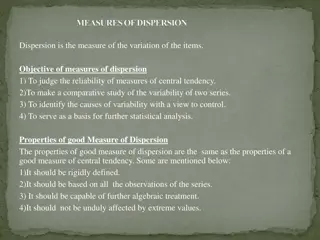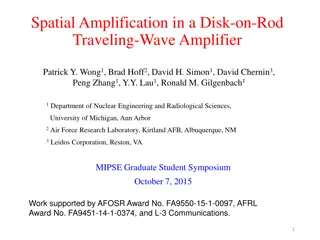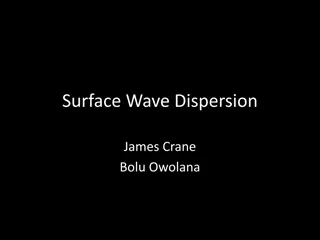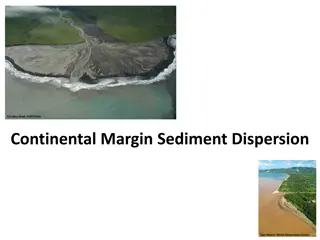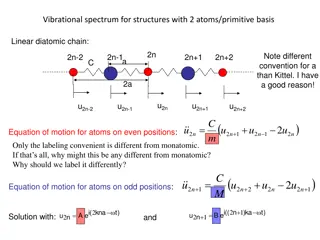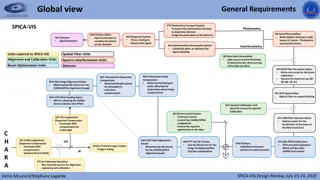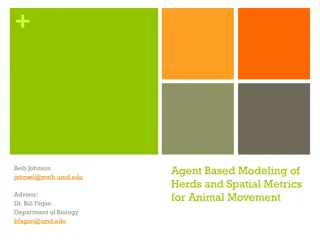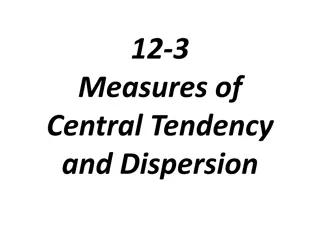Basic Meteorology Concepts for Air Quality Management
Pollutants circulate in the troposphere following air movement patterns around low-pressure fronts and high-pressure systems. Anticyclones and cyclones play a crucial role in atmospheric stability and pollutant dispersion. The relationship between lapse rates determines air stability and pollutant d
6 views • 24 slides
Measures of Dispersion in Statistics
Measures of dispersion in statistics help in understanding the variability of data points. They are essential for assessing the reliability of central tendency measures, comparing data sets, identifying variability causes, and guiding further statistical analysis. The properties of a good measure of
4 views • 8 slides
Colloids and Their Importance in Pharmaceuticals
Colloids play a vital role in the pharmaceutical industry as heterogeneous biphasic systems with particle sizes ranging from 1nm to 100nm. They are classified based on aggregation and interaction of phases, with examples like aerosols, foams, emulsions, and more. Colloids can be prepared by condensa
4 views • 23 slides
Optical Properties of Optically Active Compounds
Circular dichroism and optical rotatory dispersion are important techniques for studying the optical properties of optically active compounds. Circular dichroism measures the differential absorption of left and right circularly polarized light components, while optical rotatory dispersion studies th
2 views • 17 slides
Van der Waals Forces and Intermolecular Interactions
Van der Waals forces encompass London dispersion forces, dipole-dipole forces, and hydrogen bonding, influencing interactions between atoms and molecules. London dispersion forces are the weakest and present in all molecules, dipole-dipole forces involve permanent dipoles, and hydrogen bonding, the
16 views • 9 slides
Introduction to Spectroscopic Instrumentation and Monochromators
Today's lecture covers spectroscopic instrumentation with a focus on monochromators. It delves into the components and performance measures of spectrometers, including wavelength discrimination filters, light detectors, and energy dispersive detectors. The dispersion of light through prisms and grat
4 views • 17 slides
Radiological Dispersion Device Tabletop Exercise Overview
This tabletop exercise focuses on simulating a radiological dispersion device scenario to enhance emergency response readiness and assess response plans. The exercise includes agenda discussions, administrative details review, scenario analysis, facilitated discussions, action planning sessions, and
1 views • 32 slides
Spatial Amplification in Disk-on-Rod Traveling-Wave Amplifier Study
Explore the viability of Disk-on-Rod Traveling Wave Tube (TWT) for high-power microwave devices with wide bandwidth. Analyze the spatial amplification rate through hot-tube dispersion relations, comparing against Particle-in-Cell code simulations. Schematic diagrams and cold-tube dispersion relation
2 views • 13 slides
Intermolecular Forces: Strength, Types, and Examples
Intermolecular forces are attractions between molecules, weaker than chemical bonds. They include London dispersion forces, dipole-dipole interactions, and hydrogen bonding. Strength varies, with covalent bonds being the strongest and London dispersion forces the weakest. Different types of intermol
5 views • 15 slides
Surface Wave Dispersion in Seismic Exploration
Surface wave dispersion, explored by James Crane and Bolu Owolana, plays a crucial role in seismic studies. This phenomenon, involving waves spreading at varying speeds, helps evaluate subsurface characteristics based on wavelength. By studying surface waves, researchers can determine velocity, dens
1 views • 14 slides
Intermolecular Forces and Dispersion Forces in Molecules
Particle diagrams of liquids, solids, and gases reflect distinct arrangements due to intermolecular forces. The existence of substances as gases, liquids, or solids at room temperature is attributed to the forces between molecules known as intermolecular forces (IMF), with dispersion forces being th
3 views • 30 slides
Investigating Ship Wakes and Wave Patterns
Explore the visual similarities between ship wakes and Mach cones, considering various parameters such as boat velocity and length. Delve into wave equations, dispersion effects, and experimental results while addressing questions on water speed, wake formation, and wave models. Analyze the correlat
3 views • 8 slides
Sediment Dispersion along the Continental Margin
This content explores the influences and types of sediment dispersion systems along the continental margin. Processes affecting sediment supply, depositional environments, and different dispersal systems like Estuarine Accumulations Dominated and Marine Dispersal Dominated are discussed. Walsh and N
3 views • 8 slides
Vibrational Spectrum in Diatomic Chain Structures: Analysis and Eigenmodes
The vibrational spectrum of structures with two atoms in a linear diatomic chain is examined, focusing on the equation of motion for atoms at even and odd positions, phonon dispersion, transverse acoustic and optical modes, longitudinal eigenmodes in 1D, and extending the 1D model to 3D for phonon d
5 views • 20 slides
NOAA's HYSPLIT Model for Predicting Volcanic Ash Dispersion
NOAA's HYSPLIT model is crucial for predicting the transport and dispersion of volcanic ash. By utilizing satellite data, this model aids in issuing advisories for aviation safety. Applications of the model extend to various atmospheric tracer studies. Inverse modeling techniques are employed to est
0 views • 14 slides
Bandwidth and Dispersion in Fiber Optic Communication
This presentation provides a comprehensive overview of bandwidth and dispersion in fiber optic communication. It covers essential terminologies like microns, nanometers, millimeters, and dB, explaining concepts such as bandwidth capacity, dispersion cancellation, and modal bandwidth in multimode fib
4 views • 24 slides
Dynamic Aperture Optimization for CEPC Main Ring
Lattice design and dynamic aperture optimization for the Circular Electron Positron Collider (CEPC) main ring were discussed, focusing on maximizing the dynamic aperture through lattice configurations in the ARC region, interaction region, and partial double ring region. Various strategies such as c
5 views • 14 slides
SPICA-VIS Photometry Transport System Overview
This detailed overview outlines the intricate components of the SPICA-VIS photometry transport system, including modules for photometry, interferometry, dispersion, signal detection, and more. Key elements such as the optical fiber feeding optics, polarization delay compensator, atmospheric dispersi
2 views • 21 slides
Swedish Aid Proliferation: Challenges and Solutions
Delve into the complexities of aid dispersion in Sweden, analyzing the impact on efficiency and growth. Get insights on measuring aid dispersion, coordination vs. cooperation, and strategies to reduce costs. Explore why aid dispersion is a problem, the importance of concentration, and the need for e
0 views • 36 slides
CEPC Booster Errors Studies in EDR & Correction Process
In 2024 at Marseille, studies were conducted on CEPC Booster errors in the EDR. Initial design, simulation errors, and correction processes were explored. Key focus areas included simulation accuracy, tilt corrections, gain offsets, and quadrupole schemes. The correction process involved orbit corre
3 views • 6 slides
Using Mobile Camera Phones to Track Market Price Dispersion
Price dispersion, differences in prices of homogenous goods, can be tracked across vendors using mobile camera phones. This innovative approach aims to empower consumers by providing real-time pricing information and enabling better negotiation opportunities. The system overcomes challenges of manua
3 views • 5 slides
Underwater Trajectory Behavior of Heavy Oil Jet in Cross-Flow
This study explores the behavior of heavy oil jets underwater from a broken-surface pipeline, focusing on vertical dispersion modeling based on Navier-Stokes equations and experimental work by Delvigne and Sweeney. The research delves into the theory of wave-induced dispersion and the modeling appro
5 views • 13 slides
Underwater Trajectory of Heavy Oil Jet in Cross-Flow Research
This research investigates the behavior of heavy oil jets underwater from a broken surface pipeline, focusing on vertical dispersion oil spill modeling using mathematical models and numerical results. The study explores the movement of oil droplets in the water column and various modeling approaches
0 views • 6 slides
Effects on Dynamic Aperture of EIC: Understanding Non-Linearities and Optimization
The Electron-Ion Collider at Brookhaven National Laboratory features two rings - Hadron Storage Ring and Electron Storage Ring - with a large energy range of 30GeV to 140GeV. This article delves into the concept of Dynamic Aperture, exploring how non-linearities impact particle stability and ways to
3 views • 24 slides
Symbolic Algebra, Dispersion Matching, and Coupled Oscillators in MATLAB/Python
Explore the concepts of symbolic algebra, dispersion matching, and coupled oscillators in the context of accelerator physics. Learn about transverse focusing, dispersive transfer matrices, Chasman Green double-bend achromats, and coupled oscillator systems. Gain insights into solving complex equatio
1 views • 10 slides
Essential Measures of Dispersion in Biostatistics
Learn about the importance of dispersion in analyzing data variability, explore ideal properties of dispersion measures, and understand commonly used measures like Range, Mean Deviation, Standard Deviation, Variance, Standard Error, and Coefficient of Variation. Discover how to compute range for ind
1 views • 24 slides
Agent Based Modeling of Animal Movement Mechanisms
Explore the complexities of animal movement mechanisms through agent-based modeling, spatial metrics, and population level distributions. This study delves into non-oriented and oriented movements, spatial memory, and dispersion patterns at the population level, aiming to unify diverse movement theo
3 views • 49 slides
Measures of Dispersion in Statistics
Learn about the importance of dispersion in statistics and explore different measures such as range, interquartile range, mean deviation, and standard deviation. Discover how to calculate mean deviation from mean with practical examples.
3 views • 12 slides
Measures of Dispersion in Animal Genetics & Breeding
Measures of Dispersion quantify the variation in data sets, aiding in determining average reliability, comparing data variability, and facilitating statistical analysis. Methods like Range, Quartile Deviation, and Variance are applied, each with unique merits and demerits in analyzing observations.
0 views • 22 slides
Animal Genetics & Breeding: Measures of Dispersion and Significance
Measures of dispersion, such as variance and standard deviation, are crucial in analyzing data variability in animal genetics and breeding. Understanding the significance of dispersion helps in assessing data reliability, comparison, control, and statistical analysis. Various methods like range, qua
3 views • 46 slides
QTc Dispersion Assessment in Children with Familial Mediterranean Fever
Learn about the assessment of QTc dispersion in children with Familial Mediterranean Fever, an autoinflammatory disease, and how it relates to cardiovascular risks. The study involves 45 patients diagnosed with FMF and healthy volunteers as the control group, exploring heart rate, P wave characteris
3 views • 13 slides
Measures of Central Tendency and Dispersion in Data Analysis
Explore the concept of measures of central tendency (mean, median, mode) and dispersion (range) in data analysis through practical examples like finding means, medians, and modes of bowling scores, calculating averages, comparing data sets, and more. Understand how to interpret and analyze data usin
0 views • 10 slides
Absolute Measure of Dispersion: Mean Deviation Calculation Explained
Discover the concept of mean deviation as an absolute measure of dispersion in statistics. Learn how to calculate mean deviation and its coefficient from mean in individual, discrete, and continuous series, along with visual aids for better understanding.
2 views • 6 slides
Measures of Dispersion: Understanding Data Spread and Variability
Measures of dispersion help in understanding how spread out the values are from their center, providing insights into the variability of data sets. They include important metrics such as Range, Variance, Standard Deviation, and Coefficient of Variation. Through examples and illustrations, this conte
0 views • 14 slides
GLMs and Quantile Regression: Discussion on Topics in Formative Assessment #3
Explore topics on Generalized Linear Models (GLMs) and quantile regression in Formative Assessment #3 for PSQF 6270. Dive into discussions based on Lecture 4, covering various aspects like zero-inflated vs. hurdle models, over-dispersion vs. under-dispersion, interpretation of model results, and mor
0 views • 12 slides
Army Sniper Munition Optimization: Comprehensive Dispersion Response Analysis
Explore a study on optimizing the dispersion performance of the M118LR Sniper cartridge for enhanced accuracy in military operations. The research involved detailed statistical analysis and a custom split-plot design to meet the demands of new rifle specifications and improve target accuracy downran
0 views • 17 slides
Understanding Coarse Dispersion and Emulsions in Pharmaceutical Applications
Explore the world of coarse dispersion and emulsions, essential in pharmaceutical formulations for drug delivery. Learn about suspensions, flocculation, deflocculation, and different types of emulsions like oil-in-water and water-in-oil. Discover their applications and significance in various indust
1 views • 9 slides
Unveiling the Magic of Light Dispersion and Rainbows
Explore the fascinating world of light dispersion through prisms, rainbows, and Newton's experiments. Discover how white light splits into colors, the mechanisms behind dispersion, and the formation of rainbows in the sky. Learn about the significance of Isaac Newton's work, the applications of disp
1 views • 7 slides
Seismic Dispersion in Mancos Shale Study
Explore the seismic dispersion in Mancos Shale through experimental evidence, contradictory results, and saturation effects. The study delves into low, intermediate, and high-frequency regimes, showcasing behaviors under varying saturation and stress conditions.
2 views • 15 slides
Seismic Dispersion in Mancos Shale Study
Explore the seismic dispersion in Mancos Shale through experimental evidence, saturation effects, and frequency regimes. Contradictory results, sensitivity to fluid content, and sample characteristics are analyzed, shedding light on the behavior of this shale formation.
1 views • 15 slides

